Great Motorcycle Rides: Ruta 40 in Argentina
Of all the amazing things that Argentina has to offer (wine, meat, tango, and beautiful ladies), there is one feature that isn’t as well advertised. Running nearly the entire length of the country, along the Andes lies the Ruta 40, a road that stretches over 3000 miles (5000+ km) from Bolivia all the way to the Strait of Magellan. What can you find on such a long adventure? Let’s find out.
Facts and Recommendations
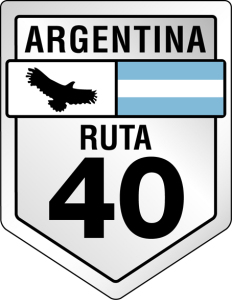
If you see this sign, you’re on the right track.
Ruta 40 is loooooong. It’s one of the longest routes in the world so it’s not something you’re going to cross off your bucket list in a couple of days. It also covers a multitude of geographic regions ranging from mountains, plains, and coast. Its lowest point is at sea level while its highest is at a staggering 14,000 ft (4,270 m). Since it runs along the Andes you can expect chilly weather throughout most of the year and keep your eye on the weather forecast since heavy rains and snow are not unexpected.
The northern and central parts of the road are mostly paved and run very smoothly. However, when you start venturing farther south – into the desolate Patagonia – the asphalt turns into compacted dirt and the true test of endurance begins.
Essential gear
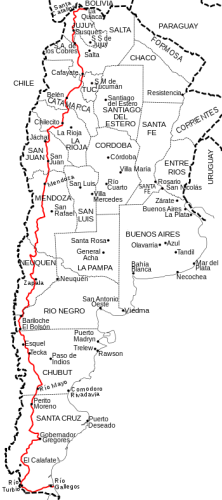
Look at the size of that thing!
Sticking to the main road is easy and signage is really good so it’ll be hard to get lost, but there are so many beautiful things to see that branch off this road. Detours include the Cerro de Siete Colores (7-Colored Hills) near Salta, the hippy village of El Bolsón in the Lakes District, The Perito Moreno Glacier, and countless national parks (including a dinosaur theme park practically in the middle of nowhere).
The first essential piece of gear you’ll want is a GPS but those looking for a more traditional sense of adventure can pick up a route map at any YPF gas station. This map is updated constantly and includes all major roads throughout the country. It also makes for a great memento that you can get framed once your trip is over. You can also get local town maps for free at the tourist booths in every town. These include references for lodging and restaurant locations.
Bring layers. During the summer, it can get very hot during the day and very cold at night. Layers are your best option, as is weatherproof clothing. You can also check out our top recommendations for apparel. Heated grips are also an excellent idea. At the very least, get some grip guards, or grip covers to shield yourself from the cold winds.
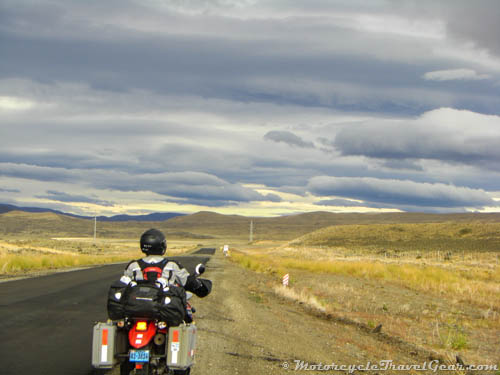
Having the right gear will keep you enjoying the road.
Good tires will make a big difference during your ride. If you can, carry a knobby rear tire that you can throw on once the dirt road starts in the south. If you’re just going to be riding on one set the whole way, I recommend a good dual sport tire like the Metzeler Karoo 3 Tires.
Your adventure starts here
Decisions, decisions. With the Ruta 40, you have the choice to start at the top or the bottom.
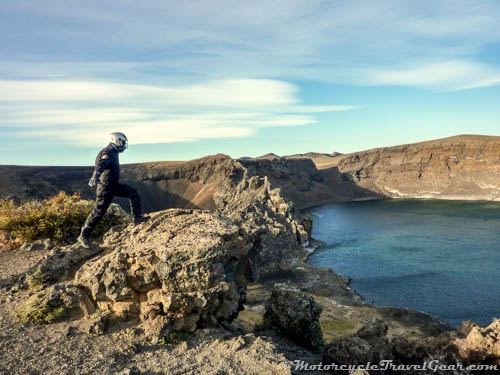
Wind blowing across the top of a volcanic crater near Rio Gallegos.
The southbound journey starts at La Quiaca, Argentina’s border with Bolivia, at 11,300 ft (3,460 m). This is is a great segue if you’re coming out from an adventure in Bolivia, like the world-famous Death Road. The way south will lead you through the beautiful city of Salta where you’ll be in vicinity of the Cafayate region. Here you’ll be able to see some of the most beautiful rock formations in the world. It’s a lot more interesting than it sounds, trust me, and the riding in the region is awesome.
Starting from the bottom gives you the chance to deal with the rough part of the road first. You also get to ease your way into the high altitude regions. In order to get here you can enjoy the coastal ride down from Buenos Aires to Rio Gallegos, or choose to fly into Ushuaia (the southernmost city in the world) and ride north in order to connect to Ruta 40.
Perhaps the easiest way to make this decision is to consider the weather. As you’ll want to take your time along this route, consider what the weather will be like at the extreme points and map it out from there. You won’t want to get snowed in at some solitary little town (or maybe you would, I don’t know).
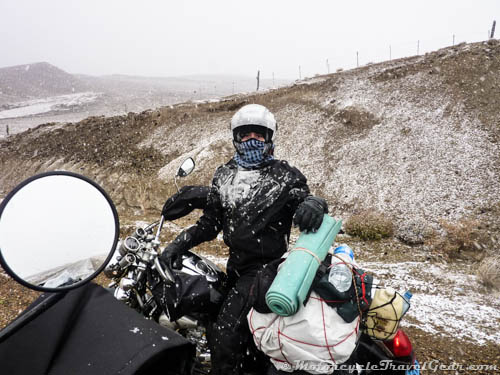
In hindsight, getting snowed on was actually a lot of fun, but don’t try it at home.
What to expect
Amazing landscapes from the colorful Andean region, to the Lakes District, and the Patagonian flats. Bring your camera and keep it charged as you’ll likely be taking hundreds of pictures along the way.
Some of the most impacting backdrops I found were near the glaciers and around El Calafate and El Chaltén. If you’re hauling tents and sleeping bags, you can expect plenty of campsites to settle down for the night along most of the route.

The Road to El Chalten
One warning that I didn’t get before embarking was how strong the winds are, especially when reaching the tip of the continent. Patagonian winds can regularly reach 60 mph (100 kph) and you’ll have to lean heavily just to go straight. Keep in mind that sudden gusts can also push you off the road so drive with caution. If conditions seem too dangerous, it’s wiser to wait it out. Just follow the lead of the locals since even truckers won’t go out if it’s really bad. That being said, one of the most fantastic experiences I had was due to raging winds in the south.
I had been riding at an angle for about two hours. The wind rushing around my helmet was deafening and battering gusts were slowing me down considerably. My muscles ached from holding the bike at an irregular stance. Then, as the road turned east, the roaring came to a sudden stop. All I could hear was the beating of my heart and the hum of my engine. I was going at the same speed as the wind and therefore wasn’t experiencing any air resistance. It was like floating down the highway. It felt like the wheels weren’t even touching the pavement. I still remember it as one of the most magical moments of my life.
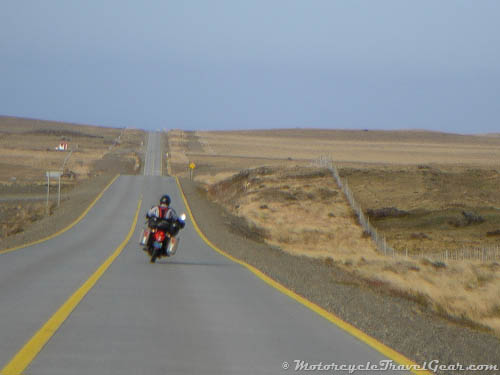
Gotta watch out for those crosswinds.
Another tip to take into account is that the farther south you go, the more distant the towns become so make sure to carry a spare fuel canister. This is especially true on the unpaved sections of the road. Riding through Patagonia can give you a profound sense of solitude at times so be prepared to handle that mentally.
What’s next?
If you’re making a southbound run, the next logical destination when you reach Rio Gallegos (the endpoint of Ruta 40) is to cross the Strait of Magellan into Tierra del Fuego and make your way to Ushuaia. That in itself merits its own chapter of Great Motorcycle Rides. After that you could head north towards Buenos Aires along the coast and see some whales in Puerto Madryn.
If you’re heading north, once you reach La Quiaca you should definitely head into Bolivia, a country that is a motorcycle adventurer’s dream. It has stunning views and rugged terrain and you’ll even get the chance to ride your bike across an area that’s the closest thing that you’ll get to being on another planet.

I wasn’t lying about that dino-park!
For more information on what you can explore while touring the Ruta 40, check out Ruta 40 Travel Guide. There you’ll find resources for lodging, eating, and all sorts of cools spots to check out.
Safe travels, everyone!
Have you traveled the Ruta 40? Let us know about your experience and what your favorite part of the whole journey was. Feel free to leave your own personal recommendations!

You need to try Geocaching my friend! It would fit in well with your motorcycle travels! As a matter of fact, there are a bunch of geocaches along Ruta 40. Here’s one even called “Ruta 40”. http://coord.info/GC4ZK4X!
Hi John,
It certainly seems like geocaching could be a fun sidequest with any big trip. Thanks for the recommendation!
What a great site… love the pages here.. makes me want to get on my bike and get on the open road. Looks like a really interesting route. I am a keen biker but live in a remote area on a small island so i rarely get the chance to take the open road.
Really great reading.
Thanks
Chris
Hi Chris, if you ever get the chance to ferry your bike off your island let me know and we can hit the road on some crazy adventures.
Great site and a wonderful review. A nice balance of text to photo ratio. You can tell that you have put a lot of hard wot into this post , you should be proud of the results.
Thank you for your kind words.
What a great post. It makes me wish I’d done a trip like that in my younger days when I had a motorbike.
It’s never too late, Ray. You just let me know when you’re ready to get back on and we’ll have you prepped for some amazing odysseys.
This is a great post. I am not good at motorcycling even though I have two, but I found it such a great travel article on this beautiful road.
Seth
Thanks, Seth. I’m sure you’re just being modest about not being a good biker even though you have two motorcycles!
Cheers.
Great looking site!! Very clean visually and the content is great! One thing that I can’t stand while riding is cross winds! Lol that picture made my cringe just looking at it.
Keep up the good work!!
Those crosswinds are nasty for sure but reaching your destination after having endured it for hours is rewarding in itself.
Thanks for the support!